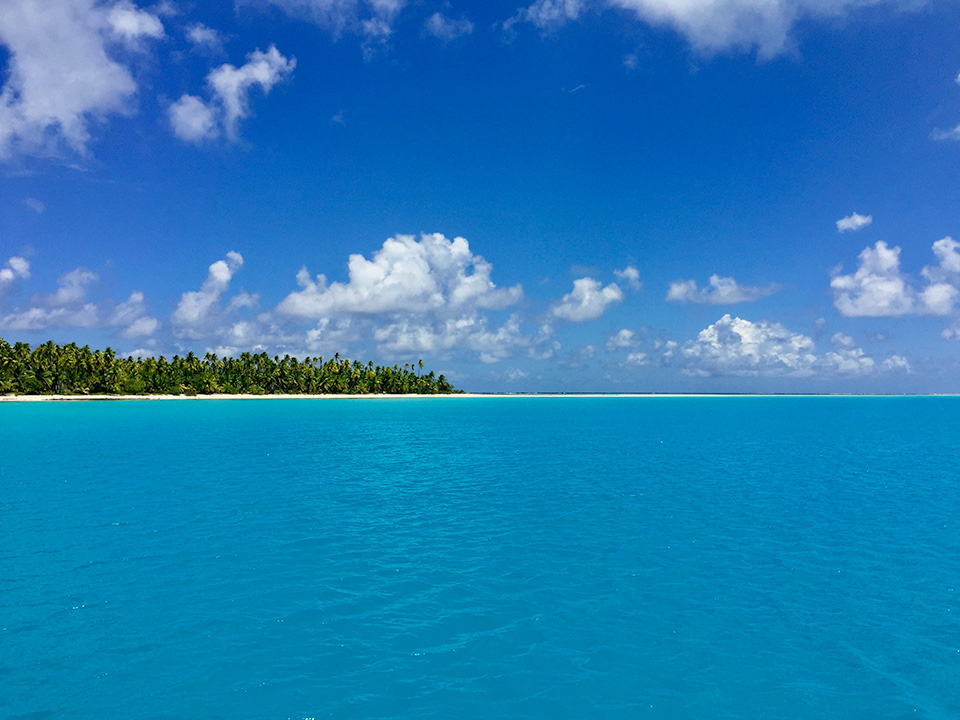
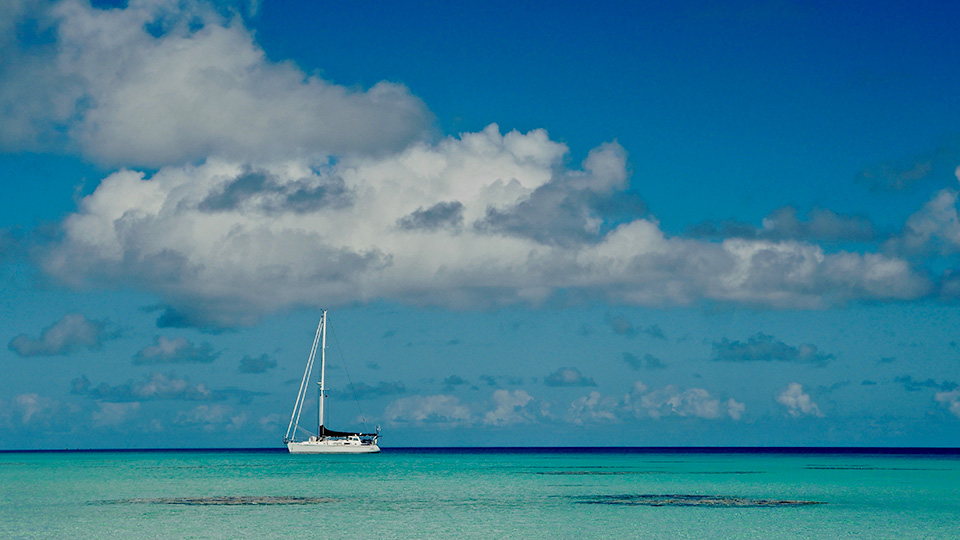
As we sailed south from the Marquesas, Diana was looking for sharks, calm lagoons protected from the ocean swell, turquoise water and coral, safe anchorage within earshot of the surf breaking on the reef. I was looking for flats — wide expanses of water that doesn’t rise above your knee in depth. Ideal for flyfishing. To reach the Archipelago of the Tuamotus, you sail by the Isle du Disappointment. We wished we had the time to detour, to see it for ourselves, if nothing else so we could say we’d been to the actual Island of Disappointment, but it was night when passed and low lying atolls are dangerous in the dark. We slipped by beneath the whisker of a moon.
Disappointment is a prerequisite for flats fishing. You must be comfortable in the waters of frustration. Particularly, if you go looking for fish that might or might not even be there. Bonefish inhabit the tropical oceans of the world, but they are not on every flat. And on the flats they do visit, they are not there every day. And when they condescend to haunt that ephemeral world, they come armed in ghostly mail, reflecting the dazzling world around them, barely visible. Liminal shapes. But you have to see them to catch them. You might spot a bonefish and she will turn and disappear right before your eyes. You will wonder if you have seen her at all. Often the only thing you can see is not the fish itself, but its shadow on the sandy bottom.
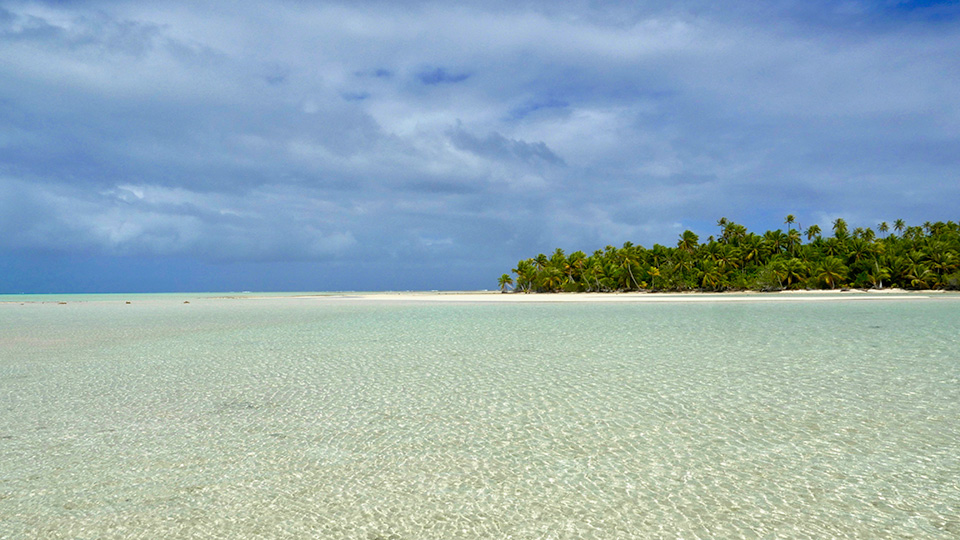
These atolls have long been known by sailors as the Dangerous Archipelago, and before GPS and Google Earth came along, most gave them a wide berth on the downwind run from the Marquesas to Tahiti. They get more visitors nowadays, but their isolation means that beside a select, well known few with air strips, the only practical way to visit is to sail there in your own boat. It took us twenty-five days to reach the Marquesas from Panama and another three days of fast sailing to reach the first of the atolls.
It’s a long way to go and nobody sails that far just to go bonefishing. Not even me.
We chose the Raroia atoll as our first stop because it was the most windward of the Tuamotos that we could easily reach from the Marquesas. It also has a well known, well charted pass for entering through the reef. We had no idea what we might find on the flats there, and nothing in google earth showed up that looked like the classic sandy bottomed expanse you’d find in the Bahamas. I expected something like the gentle reefs of Turneffe flats in Belize, but what we found was not like either. The reef itself looks like a rocky moonscape when the tide is out. It is hard bottomed and the rocks and coral are viciously jagged. Near where we anchored, there were the rusted remains of a shipwreck, the massive engine block and parts improbably strewn through the shallow water. It was easy to imagine the churning caldron that this South Pacific reef would be in a storm. The surf breaking over the reef at high tide sent wavelets rippling over the flat and the current in the cuts reminded me of wading the Madison River. It was a live, active environment. It did not look like a place you’d find bonefish, and I did not.

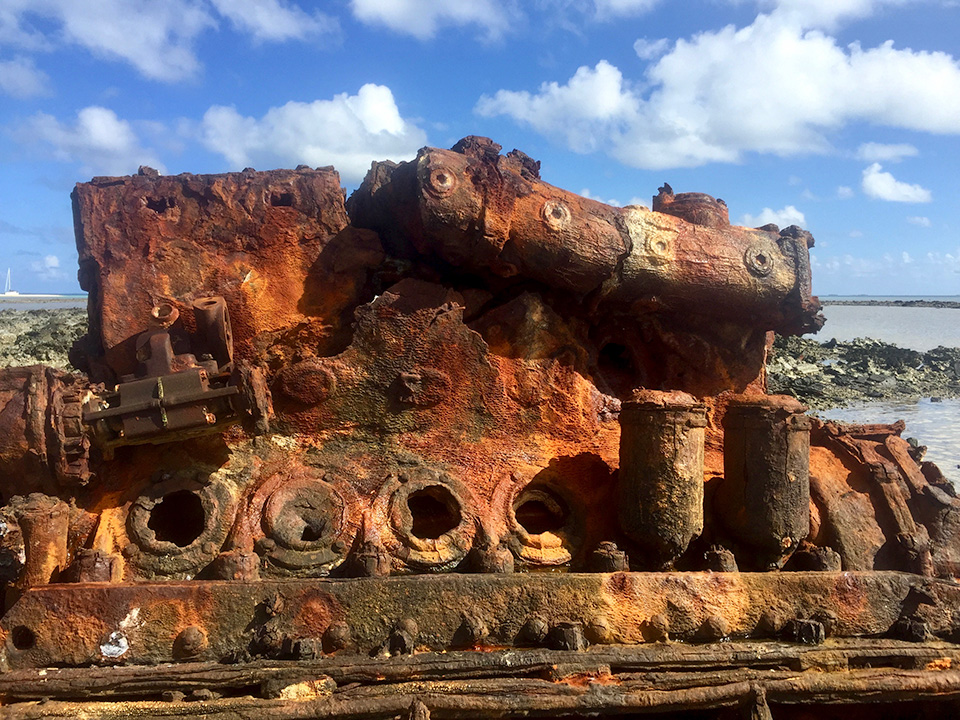
What we did find, was first and foremost, sharks. Black tipped reef sharks make a fine living in the Tuamotos. As a top predator, they seem like the sign of a healthy ecosystem. The coral here teems with fish like an aquarium. The closest I could find to a “flat” were some sandy shallows on the lagoon side between the fast running Hoa’s (Tuamotan for the cuts in the reef). There were also lots of other fish, and I quickly hooked my first Bluefin Trevally which went screaming across the shallows just like a bonefish. It happened fast and was so easy, I initially underestimated this species. These crazy, nervous, spooky, wild fish have since put me in my place. Bluefin Trevally is a beautiful fish, and the couple that rushed in and grabbed my fly, as opposed to the dozen that bolted away at the speed of light when they heard the line hit the water, were as powerful as any bonefish, maybe a little less fighter jet and more raw power, but ripping into my backing nonetheless. One of the first I landed broke the tip of my new eight weight rod. I also caught some smaller blue jacks that were fun (one shadowing a shark), and a less than gorgeous but hard fighter called a Long Nosed Emperor fish. On Raroia, I found a version of flats fishing, but not bonefish.

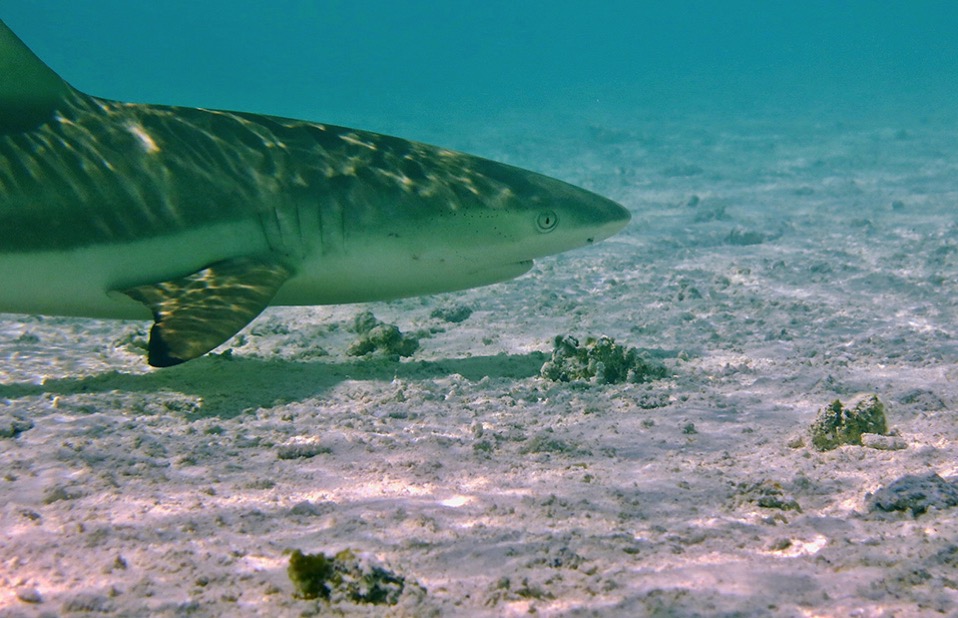

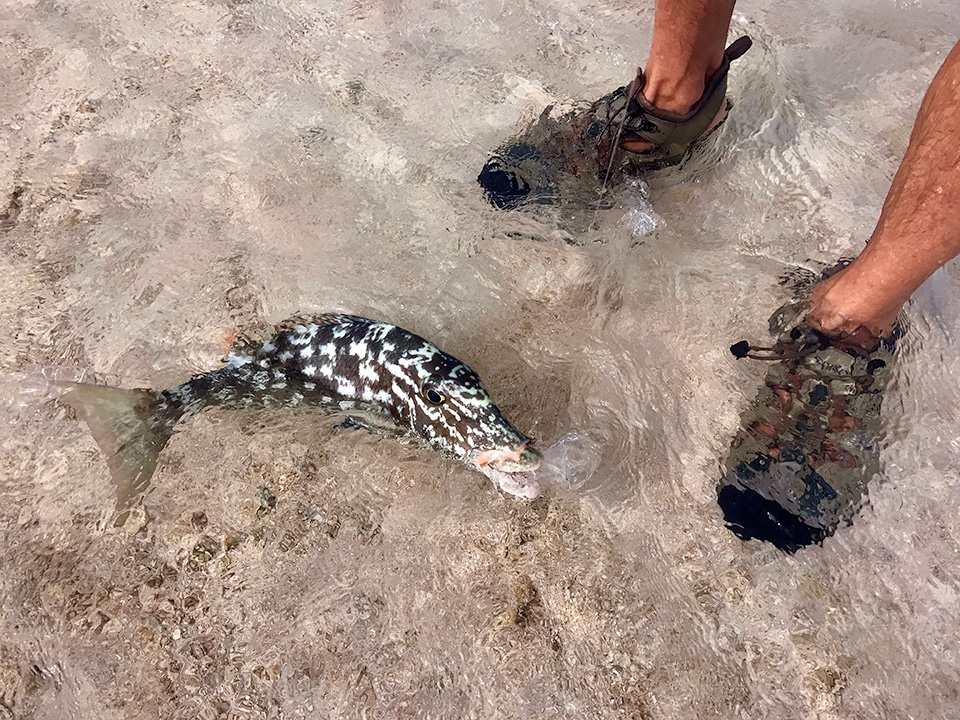
I had read that we might find bonefish on Kauehi, another atoll due west from Raroia. A Montana fly fishermen (like myself) posted a short article about catching them there years ago. He and his wife had crewed on a sailboat crossing from Panama to Tahiti, and Kauehi is a natural, first stop in the Tuamotos. A beautiful island with a charming village, the seductive if elusive promise of internet at the post office, and baguettes on Saturday and Wednesday (a slightly chewy “wonder bread” version). This is one of the atolls with flights from Papeete.
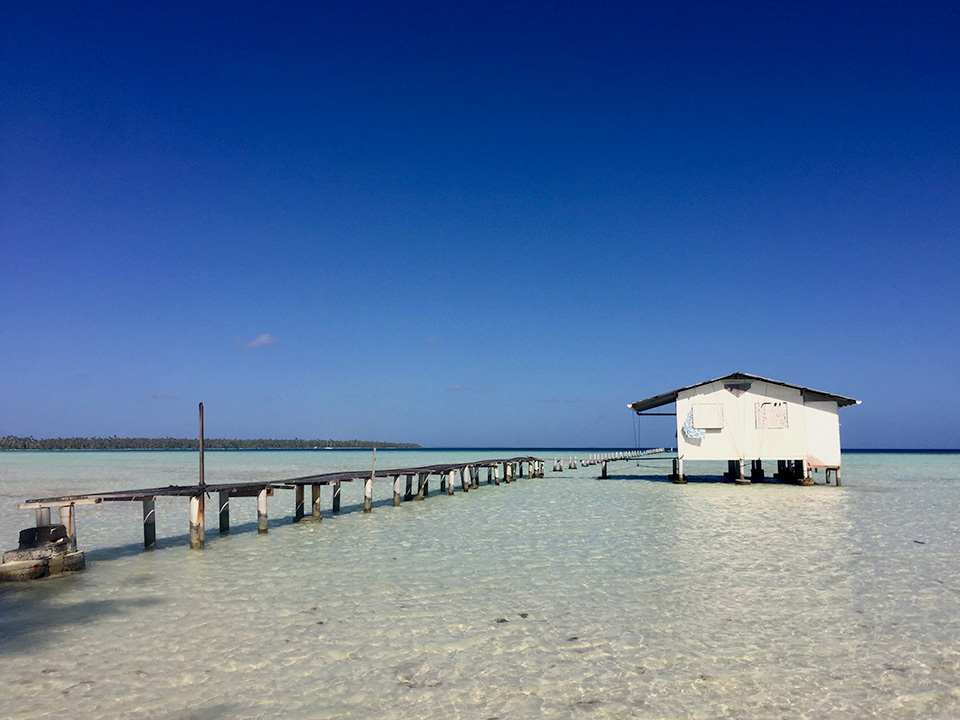
I saw what I thought must be a pair of bonefish almost as soon as I waded out onto the town flat. But they disappeared quickly and soon I was questioning if that’s what I’d seen at all. It took more than an hour to find another pair. I blew the cast completely, trying to compete with 15 knots of wind. Now the question was if I’d get another chance to cast, or if I’d just botched a very rare opportunity. When I finally spotted the next fish, I forced myself to slow down and tiptoe quietly into a crosswind position and wait until I could make a short cast. It paid off, and I had my first Polynesian bonefish on, ripping way across the flat throwing rooster tails of water as it unspooled line like no tomorrow.
An old man (well, not that old, but with a gray beard like me) was taking a Sunday afternoon nap under an awning at the beach. With the southern winter trades, the temperature in the shade is perfect. I felt bad disturbing him marching across the beachfront of his idyllic bit of paradise, but he waved me over in that friendly Polynesian style, and I showed him a picture I’d taken with my phone of the bonefish I’d just caught on the flat in front of his house. He confirmed that they are called kio kio here and told me (in French) that they made excellent Poisson Cru, which is a yummy dish we experienced in the Marquesas, made there with raw tuna, lime and coconut milk. He didn’t seem particularly startled to see me out wandering around the two mile long flat near town, but when I asked Gary, the french dive master of Ephe Mer Plongeé, who’d been living aboard a sailboat in Kauehi with his wife and son for five years how often he saw people fishing out on the flat, he said, “Never. Nobody ever fishes out there.”
Obviously the locals do, I saw them come in with parrot fish and trigger fish they had harvested with a spear. So that’s not what Gary meant by nobody. He meant no off-islander with a fly rod. The young Polynesian man who showed me his spearfish catch, thought the triggerfish would eat my fly when I showed him what I was fishing with. And they did, though it wasn’t quite that easy, though certainly more than it must be stalking these skittish fish with a spear.
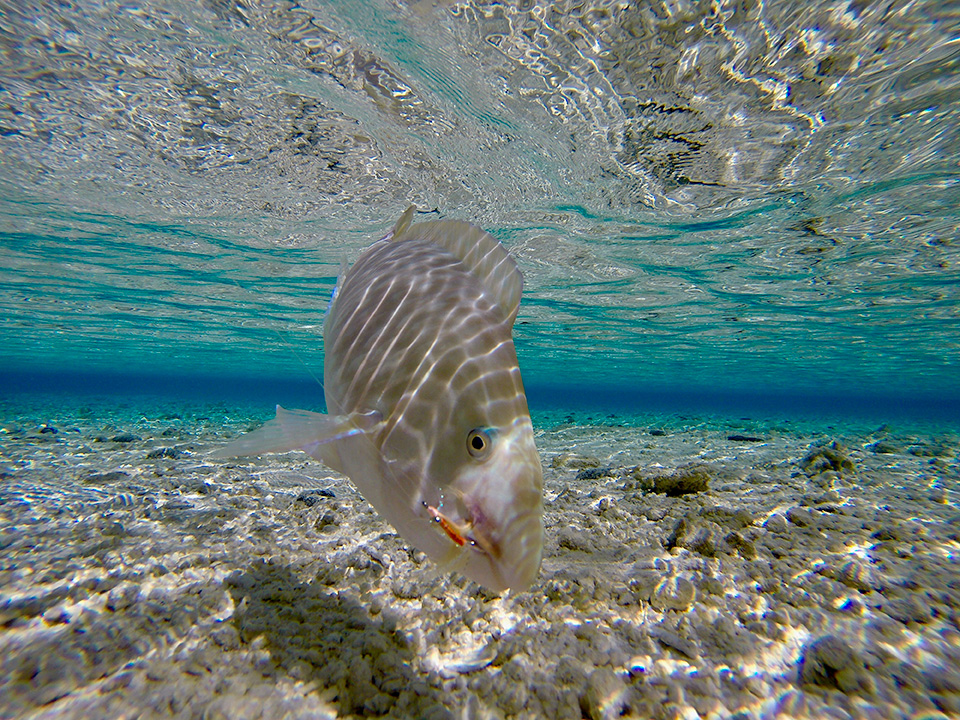
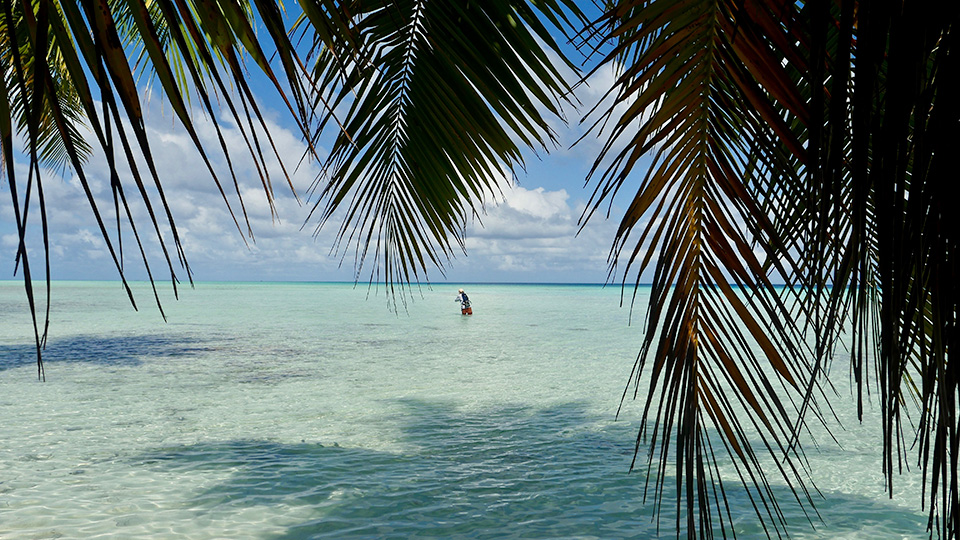
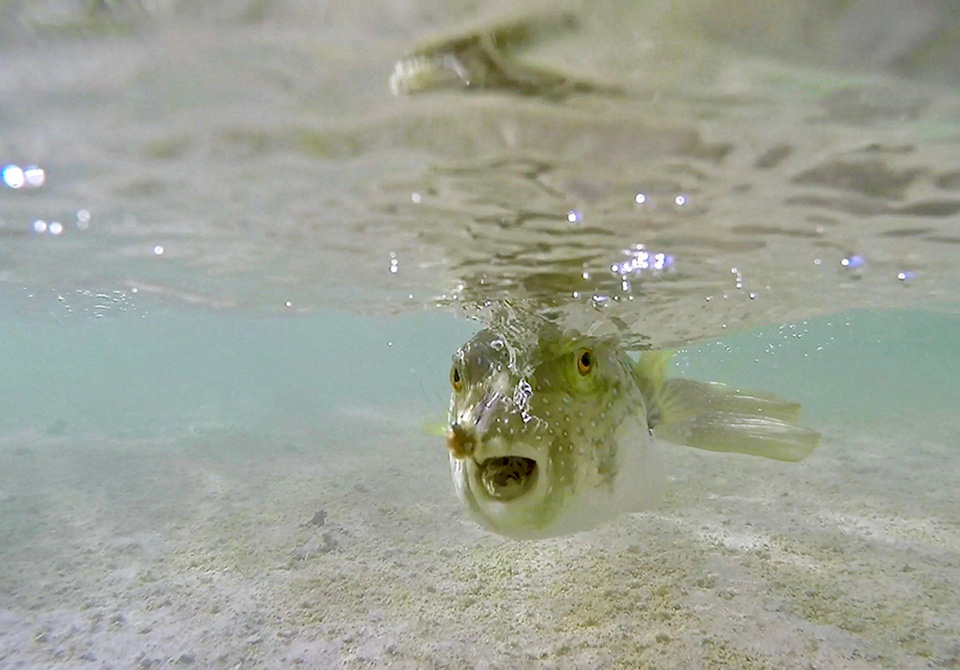

Fishing here is a way of life and it’s about food. It fits most people’s image of fishing — casting a baited hook into the dark water and waiting to see what you might happen to drag up. Flyfishermen are not that different from other fishermen, in most basic respects. Their attraction to the game varies according to the particular part of it that keeps bringing them back, the aspect of flyfishing that rewards and maybe also torments them. It’s like other games, like love even (yes, I did say that). For some size matters. For some it’s the battle and the conquest. For some it is the flirtation and the take. It’s first sight, the beating heart of the approach, the cast. The strategy and the plan. You only have to walk into any fly shop to realize that for some, it’s the fashion. For me, though there’s no doubt, it is true love, for all of the above.
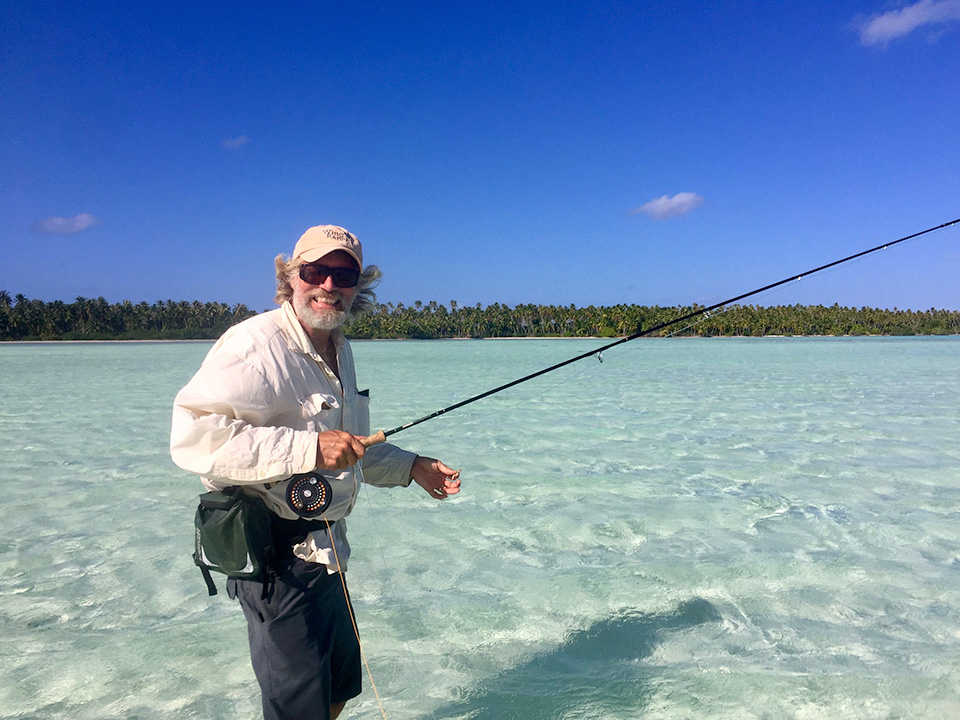
A passion (or possibly an addiction) for salt water flats fishing, particularly bonefish, is something one comes to naturally as a fly fishermen for trout. It’s particularly seductive for a dry fly fisherman whose been bitten by the bug of rising fish sipping small dry flies in the gin clear waters of Montana.
Seeing the fish, stalking, presenting the fly. Precision. Timing. Delicacy. The take and the set. Those are the common elements of the game. A dry fly fishermen must remove himself from the fly, and any hint of current that might pull on the line, so the presentation floats naturally on the surface. The bonefishermen needs to learn how to move the fly the way the bonefish expects it to move, learning the timing of their body language to know when they’ve taken the fly and give them enough time not to pull it from their grasp.
Dumb luck will catch a certain percentage of fish anywhere. But it won’t work often enough to keep it interesting. If a game is too easy, it’s not really worth playing, right? On the flats, like so many things in this concentrated environment, mistakes comes fast and furious. Miss the cast, miss the set, break off. Bonefish almost never give you a second chance.
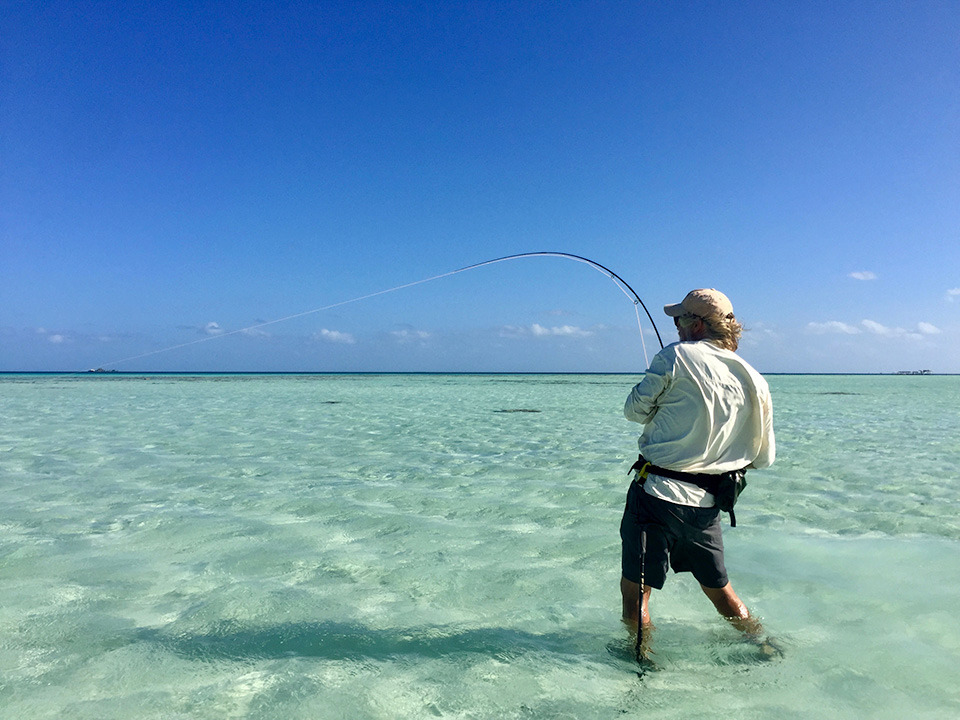

In Toau, the next atoll we visited, Diana saw bonefish swimming under the boat. In general they were concentrated closer to shore, probably because even though the flat is huge, most of it has three feet or more water even at low tide. Also, nobody lives here most of the time. The shallow edges go on for a couple miles. This atoll is one big step further away from the world. You cannot fly here. It’s only seventeen miles from one of the biggest and most populated atolls, Fakarava, so it isn’t that far. I saw the first pair before I really stepped into the water after taking the dinghy ashore. Another single within a few minutes after that. I landed the first fish within an hour of stepping onto the flat. Which was a nice start.
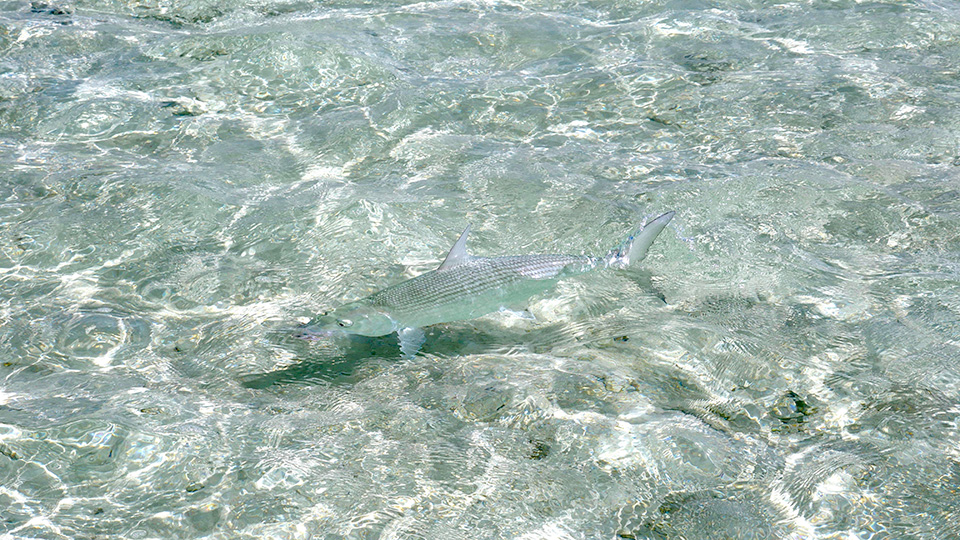
It hasn’t been non-stop like that, by any means. These fish aren’t easy. They spook at the line more than the fly, but they don’t like to hear it plop down. I started using a long tippet and tying my flies with lighter bead eyes so they can land more quietly. The colors that look right to me in this environment are tan with a touch of orange. It needs to belong but can’t be camouflaged — just sparkly enough to get some attention. They bead eyes are heavy enough to make sure it sets on the bottom which I think is crucial here, but not so big that they make too big a splash. In my previous iteration, I used ‘bunny fur,’ which I thought would be good for the splashdown, but I think it was too white. My final pattern used tan squirrel with 6 strands or so of iridescent flash. I caught 7 bones in total, six on this fly in less than three hours on the flat. I’ve been catching fish in water with no ripple on it, right up against the long beach, so I can watch them investigate the fly. Occasionally, they are pretty aggressive about grabbing it, but mostly they follow first, then take it only after it drops like it’s trying to hide. They seem to be used to the idea that whatever it is they are eating, shrimp or crab, is going to try to bury itself in the sand, not swim away. You really have to wait on the set. See them root down on it. They don’t take as long as the Triggerfish, which flop back and forth over the fly like they just can’t get ahold of it, and no wonder with that little mouth which looks overdo for a visit to the dentist. I try to resist casting to them now, because they almost always mangle or break off my fly, and I have a limited number of hooks in my fly tying kit. There are no fly shops for hundreds if not thousands of miles. That said, the other day I couldn’t resist, stupidly, casting to a grouper when I reached the rocks at the far end of the flat. He grabbed the fly in a dash and then didn’t seem to realize he had it, chasing away another small fish that had come out to investigate. I had to give him a tug for him to feel the hook and then he was off, straight for his favorite rock. After walking over reeling up all the line, I could feel he was still on, but I couldn’t pull him out from under the rock and eventually broke him off. After a bit he came out, the fly gone from his mouth, and glared at me like he was considering picking a fight.

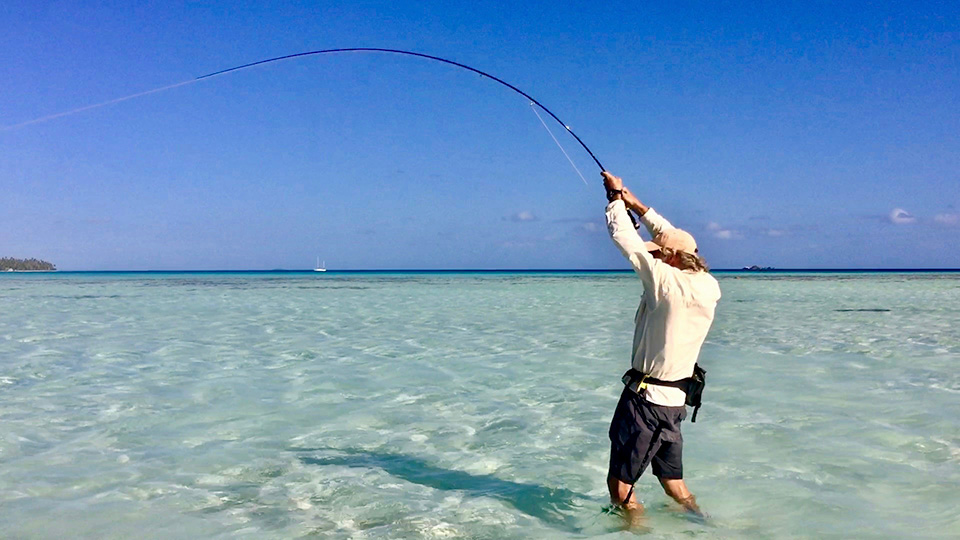
Probably the most exciting thing about Toau bones is that sometimes I find tailing fish. It’s not like smaller Belize bones tailing in groups on the flat, these are pairs or big singles. Big tails. They don’t work a spot for very long, but they aren’t in a hurry either. I hooked a really big one in about eight inches of water. I was lucky because he was moving directly at me. Even so I spooked him and had to recast as he scooted along, now broadside. This time the fly hit the water in the right way and he turned to find it. The take was clear and obvious, an easy set. The fight was unforgettable. He was off at warp speed (of course) and ran toward the shallow without stopping until he reached the shore. Then he turned a hard one eighty. I started reeling frantically (as you do) wishing at that moment I had a large arbor reel instead of my classic old Abel. But nothing was going to keep up with this fish. I reached for the line to start stripping by hand out of desperation, and then jumped. This huge bonefish nearly ran me over in his panic. I still had backing out, and he was zinging past my feet. I assumed he was long gone, but then he hit the end of the line, still on, and turned on a rocky shallow spot. Some poor fish there leapt skyward to get out of his way as he ripped across less than six inches of rock strewn water and in a second it was finally over. Somewhere the tippet had found a sharp piece of coral.
Day 3 on the Toau flat, I think (nice to be losing track), the fish conspired to humble me. My first big theory that it would be good to have low tide in the middle of the day turned out to be exactly wrong. Despite great visibility, and probably because of it, I did not see nearly as many bones. Fewer sharks even, until the tide started to come in as the sun dropped. After three thirty it gets hard to see at any distance except over by the shore where the windless water reflects the darker trees. I finally landed one fish out of a pair, but before that, it was either, wrong time, wrong fly, wrong cast, wrong presentation. They followed but would not take. I could see their eyes as they came in that close, but they wouldn’t pick the fly up.
With their 3D world reduced to two dimensions, and the sun a glaring light, Trevally are a nervous wreck in shallow water. They don’t know what they want to do. They cruise at high speed looking for an ambush with none of that sharklike cool. When they blow up at the slightest provocation, they streak away and then seem to worry that they’ve made a mistake and streak back in to see what they’re missing, then blow up and away again. They dart at the fly as if they know they are making a mistake. I cast to a pair of Trevally cruising inches off the beach and they left so panicked, I think they moved to the next atoll. But then later, I was able to get a cast fifteen feet in front of a pair coming toward me, a little further off. The first fish charged the fly from that distance so fast I have no idea whether I was stripping or what I was doing, but he was on! Another Trevally half an hour later startled me by bashing something under the ledge of the coral right at the shore and then came racing out my way. I cast to him, but I don’t think he saw the fly. He was too busy looking right at me.

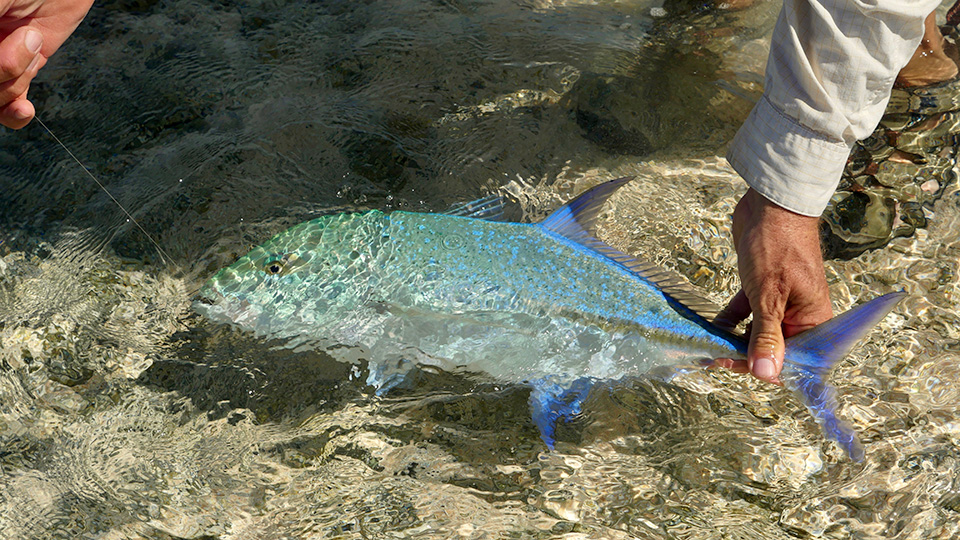
I guess I have been a little skittish on the flats, too, and maybe for the same reason. There are always lots of black-tipped reef sharks everywhere I wade. Curious as cats, with (presumably) bigger teeth. Early on, two of them, inspired by my splashing in shallow water charged in and hit my leg. Unnerving to say the least. Several others came swimming in at high speed, and finally I ended up bumping one six footer on the head with the butt of my rod to stop it. So there it is, full disclosure, there are lots and lots of sharks in the Tuamotus. I started carrying a walking stick for discouraging sneak attacks.
8:30 is about as early as the light works. The water feels cooler in the morning, but I think the light is more significant. These bones seem to stick to the very skinny water and so when it’s straight overhead they are skittish or not around. I saw more bonefish early, including tails. But I was having trouble getting the sequence of things right. Fish headed the right direction. Cast close enough, but not too close. Fish seeing fly but not spooking because it’s moving too fast. Timing right on the set, not too soon, not too late, not too quick, but quick enough. Tight line on the fight, keeping fish away from any rocks. Landing and releasing the fish without alerting any of the bigger sharks. It’s a long list. I headed back a little later than I had planned, around 10:30, Cast, hooked, landed two fish on the way back. The sharks found me after releasing the second one. I thought the bonefish must be okay, but the bigger shark, darker in color was very aggressive in swimming directly up to me. I think he could smell the bonefish in the water about me and he was sure he would find it at my feet or in my hands. I still don’t think he would bite me unless that bonefish was actually there and he could take it from me. That might be a different story. Though, I told myself, since evolution would not have designed them to bite human legs, standing ones anyway, I wonder if he would or even could be able to turn sideways in the shallow water in order to take the bite. So maybe he couldn’t bite my leg even if he wanted to. These are the kinds of things you think about on a Polynesian flat. I had to beat the water with my shark stick a couple times and then it tore off. I assumed it was because I had taught it a lesson about messing with a stick carrying member of homo sapiens. But then he started zig zagging at high speed. My heart sunk. He was chasing something. What’s truly astonishing about these sharks is how far away they must be able to sense a panicked or tired bonefish. Somehow they know the fish are too fatigued to outrun them. I’ve seen them working the flat where I’ve just released a fish like bird dogs in Montana.
Because of the couple of sneak “attacks,” I’ve developed the habit now of turning all the way around ever so often to make sure I’m not being stalked. It seems like a good idea anyway. On a flat, unlike a river, a fish could be coming from anywhere. One of the things I’ve noticed is that sometimes there’ll be a couple of nervous blue jacks following my mud trail. I think the sharks come from that direction for the same reason. They investigate all anomalies on the flat. You (if you are a shark) never know. This time about twenty or thirty yards behind me at the end of the faint trail I was leaving in the sand was a bonefish following me. I turned and made the short cast to an easy fish. He tailed on the fly nicely. Now I was sure that this new fly pattern, which had evolved from my short experience in Toau and in Kauehi, was the perfect Polynesian bonefish fly.
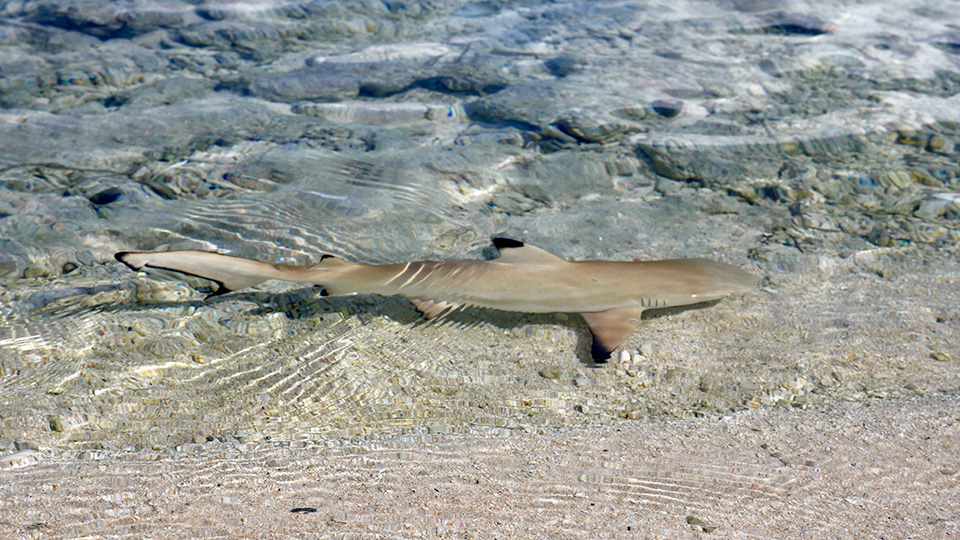
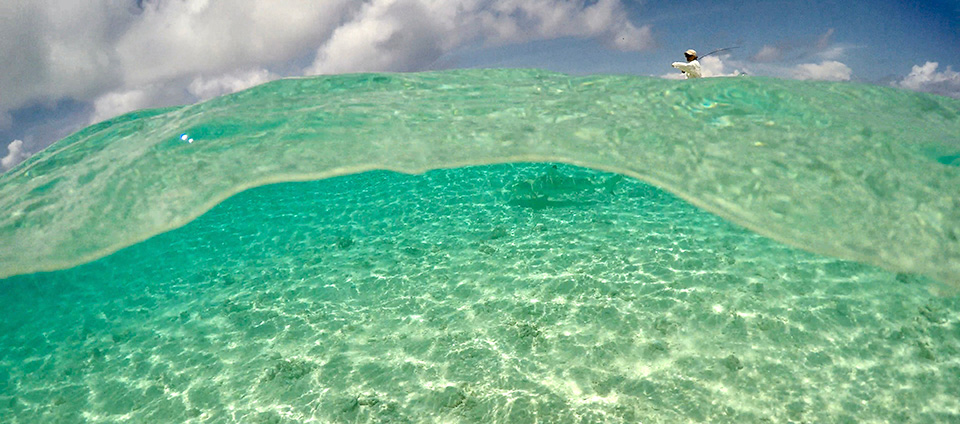
Day five on the Taou “town” flat. We explored “town” today. So far what we can find are the remains of a half a dozen structures. There are a couple of hard hats around that must be for the safety of working in the coconut groves, but the shacks are falling down. This was my most successful day fishing so far. The High tide was 6:52 and low tide was 13:06. I didn’t leave until 10 because we spent the morning doing some boat work. I scooted off, guiltily, leaving Diana finishing the job, cleaning oven parts on the stern. As soon as I started toward the flat after tying up Namo (our dinghy), I came upon two Trevally working quickly up the beach, as they do, not two feet off the edge of the water. I moved up the bank and walking as fast as I could without running I was just barely able to catch and pass them. I kept moving until I had time to get down to the water’s edge and strip off enough line for a cast. I made the cast at least ten or fifteen feet short, so I could move the fly when they got close. Even at that distance they reacted at the speed of light. My thought process barely had time to catch up with what was happening. They spooked right? Even with plenty of wind to hide my line noise and even casting way ahead of them. They are so hyper sensitive, they just blew up. No way to catch them in this scenario. Except that… my body was moving ahead my conscious thought process, and I stripped out of habit. And, unbelievably, a fish was on. Besides sailfish in Mexico, these are the most beautiful fish I’ve ever caught (okay, maybe not the mug, which is a little dopey) but the coloring is spectacular. The second Trevally did not abandon his buddy for a good part of the fight and I found out when I landed him that these Bluefin do have small teeth, like a brown trout.

It was a nice start and it got even better but then worse. I had barely waded onto the flat when I spotted a pair of bonefish. They were moving slowly enough that they were clearly looking for food. When I’ve cast to fish here that are really moving across the flat, they spook, or if they follow I get a refusal. These fish were in 6 inches of water. Really. I was lucky with my cast. The wind subdued any line splash down, and the fly went into the water without too crazy a plop. The one fish turned on it followed and took the fly without hesitation. Because I didn’t want to lose the fish to a shark and because I knew my tippet was stout, I pressed the bonefish pretty hard and when he was close I leaned heavily into the rod to get his head up and bring him in. I slipped the barbless fly out of his mouth and as soon as I let him go, I noticed what had happened. I had broken my rod tip. I’d already broken my eight weight at Raroia on a Trevally (also no spare tip, yes I’m that foolish). Looking at the tip of the rod was a lot like looking at the water when you’ve dropped some crucial boat part overboard (like the oil drain plug on the outboard for instance). Something you can’t just replace with a clever substitution. You just can’t believe that something so irrevocable has happened so quickly that could have such major consequences. The most immediate consequence was that I had to stop fishing after a late start with low tide just two hours away. I had one more rod. An eleven weight, which was going to make delicate casts a challenge, but at least, I had something to fish with for the next two weeks before the Lawsons, Maddi and Wyatt meeting us in Tahiti could rescue me with spare tips.

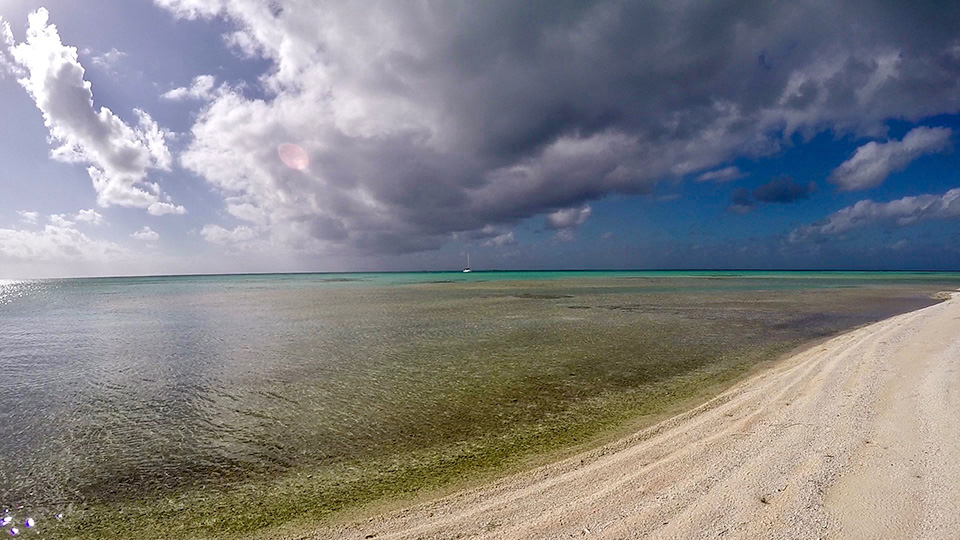
Fool me once shame on you, fool me twice… right? Two Titan Triggerfish on the flat, doing their clowny triggerfish thing. I’m thinking, this is exactly where I saw them yesterday. This must be their “spot.” But I don’t cast to triggerfish, right, that’s my rule, especially when I have just one left of my amazing new fly design that has been working so well. Nope, not doing that. I should also be remembering what happened the last time I hooked one of these goofballs, right here where I am. Just yesterday. The fish didn’t run, just swam casually over to a hole under a rock that you would not imagine was there out in the middle of the big flat. How’d that work out, Einstein? No, I’ll only cast to this triggerfish, if he makes it so tempting I cannot resist. What? Yep. When he ended up under the same rock with my precious fly again, I could see there were only a few inches of tippet ahead of the leader. Still I did not feel like reaching under that rock. I haven’t been touching the triggerfish cause I think they have some mean spines on their dorsal fin and I definitely don’t want any of my fingers anywhere near that mouth of theirs. Those beaver teeth could snap a finger off, I’m sure. I tried goading him out with my shark stick to no avail, so I finally resigned myself to losing my fly and walked away, glad there was no one… absolutely anywhere for miles and miles who could have been watching me behave like such an idiot.
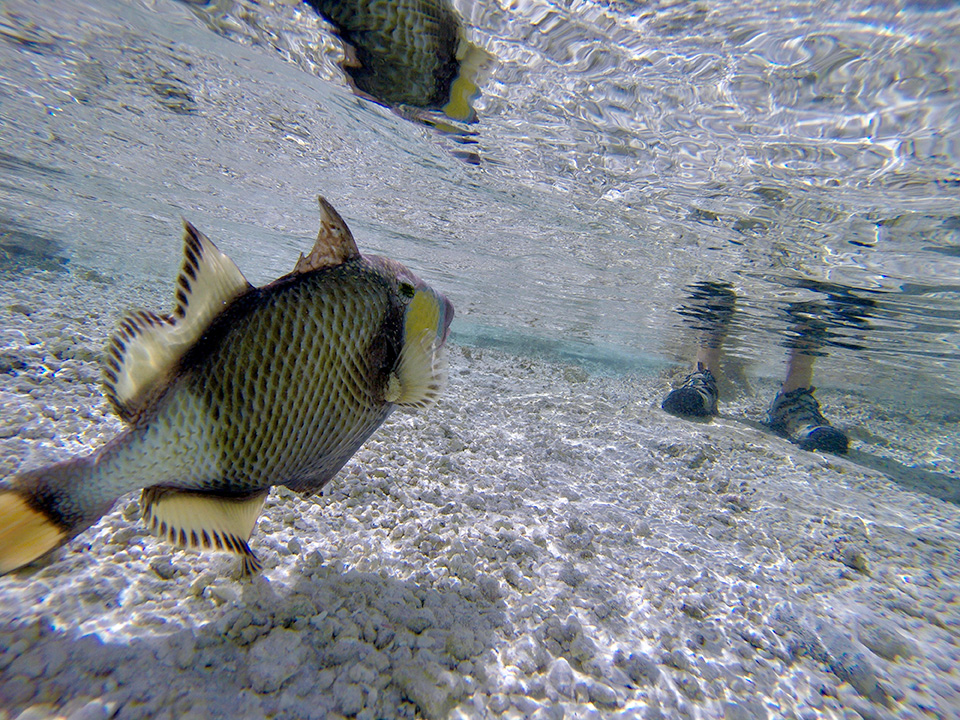
But on the northwest side of Toau we moored next to some friends, Rand and Ellen on the catamaran, Golden Glow. Rand was curious to see bonefishing firsthand and we ended up visiting a flat south of there — Rand Ellen, Diana and me. It was a little nerve-wracking because I’m not used to having an audience and there were obviously no guarantee we’d even see fish. I hadn’t even see the flat before. It just looked right on Google Earth. Luckily it didn’t take too long to find a group of bonefish which were waiting for the tide to get deep enough to get through a shallow pass to an inner lagoon. With camera’s trained on me, I hooked one and then, miraculously even landed it, giving everyone a completely wrong impression about how bonefishing usually goes. I hooked another a bit later, but lots of sharks started showing up and I felt lucky to allow the fish to throw the hook before they found him.
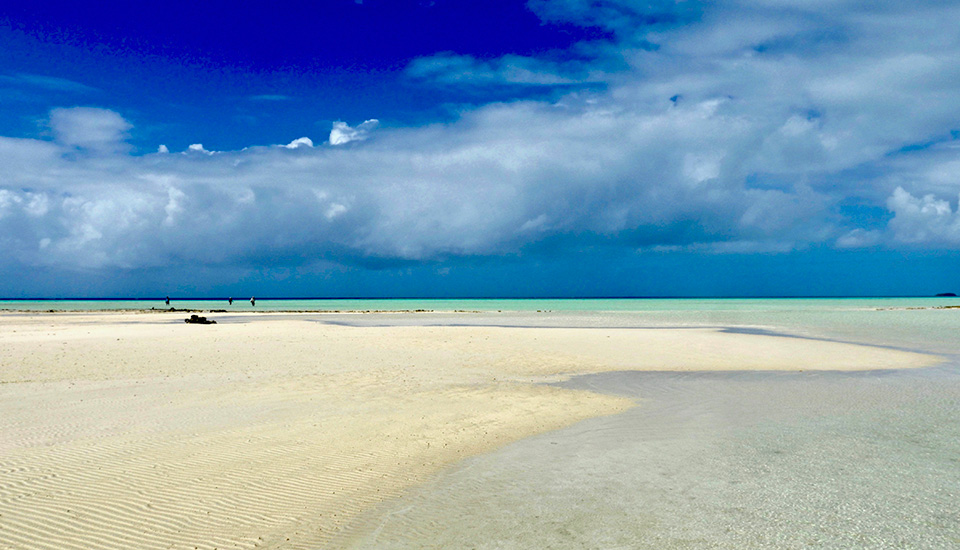
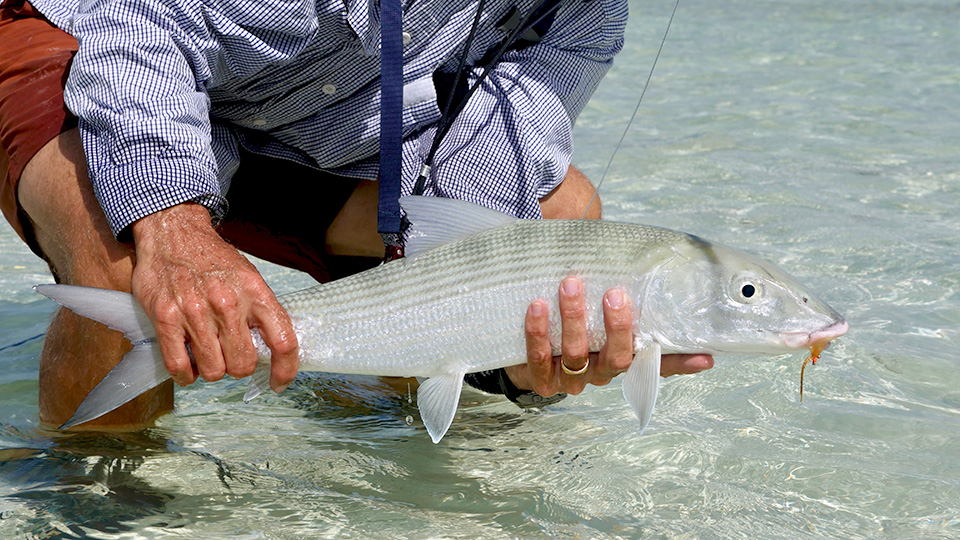
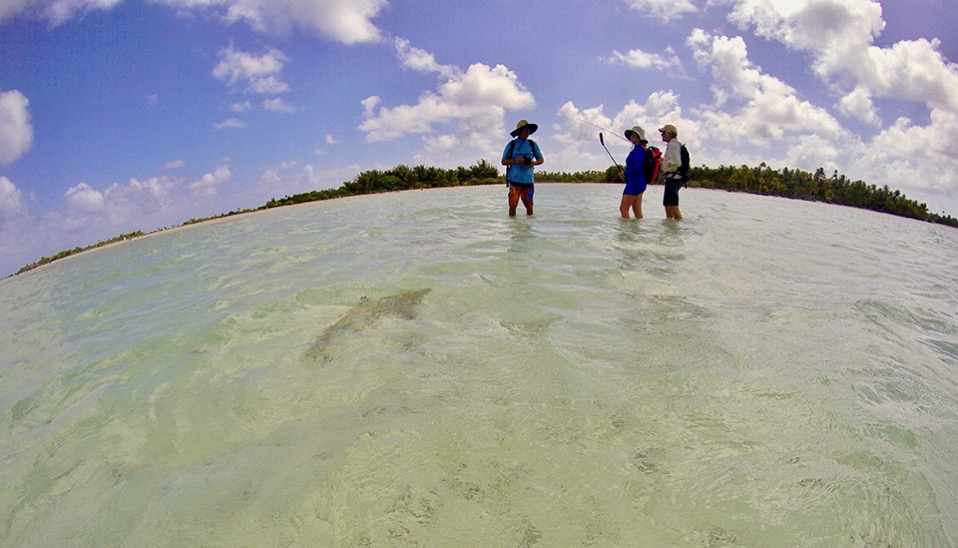
Sharks add an element to fishing here which I have never experienced in any other kind of fishing anywhere else (no toothy predators on a spring creek, though there may be other hazards for your sanity). The first adjustment requires getting comfortable with their constant presence and relentless curiosity. That can make being on the flat a little edgy. Constantly reminding yourself that sharks are best dealt with calmly. Escalating is always a bad idea. There’s the occasional really big shark like the one I had to bonk with butt of my rod in Raroia, that makes you question if what you think you know about them is really accurate. And then there’s the dilemma of trying to practice catch and release in a fiercely competitive, predator rich environment. The Tuamotos teem with fish like nowhere else I’ve ever been. The ecosystem feels as close to undisturbed as I can imagine. Sharks are everywhere and they are a part of that. When we dive the pass, there are hundreds of them and they demand our attention and fascination. They are not dumb fish. But looking over your shoulder when you hook a fish adds an unwlelcome extra challenge to the fight. Watching a fish explode in a puff of red, when a shark gets him, and then watching the shark really getting his sharks instincts up, makes you at least momentarily question the whole game. Obviously its not a game the bonefish want to play, and it wouldn’t be a hard argument to make to suggest that maybe it’s unethical. I’m sure it’s a coming argument that catch and release of any fish isn’t ethical treatment of animals, especially when it endangers their lives. On the other hand, sharks need to eat, too.

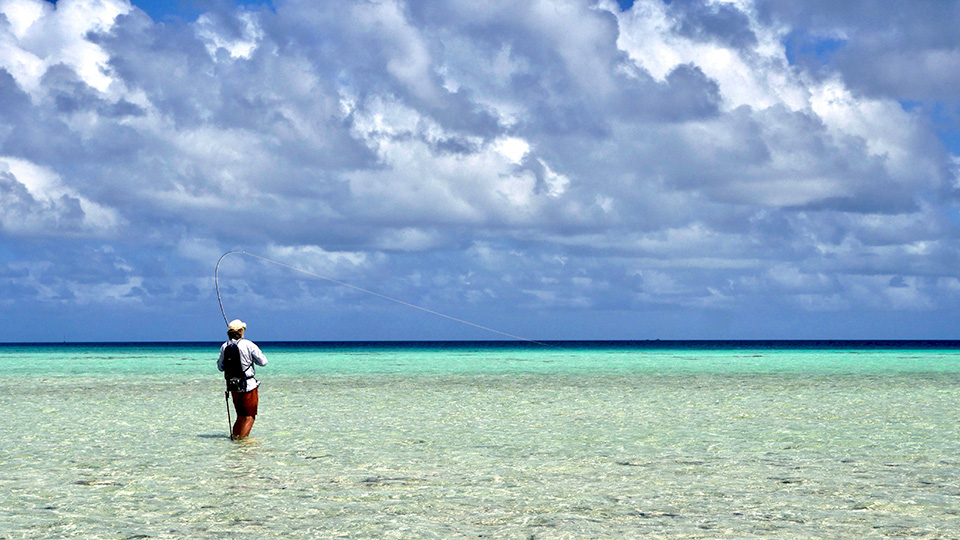
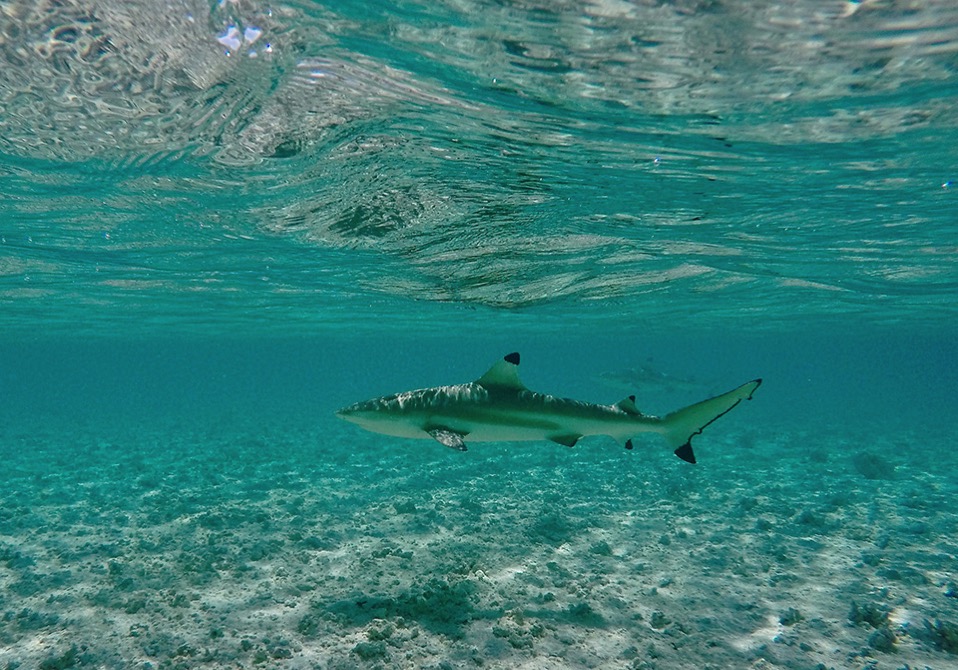
Anaa is an atoll without a pass for boats to get inside. This means we could only visit in certain conditions which just happened to occur as we were sailing back from Tahiti to Tuamotus. We tied up to the massive buoy that used to be used by the weekly supply ship. It wasn’t a great situation, and eventually we dropped anchor, but the bottom’s rocky and we had to worry about getting our anchor back. To get inside you shoot a tiny little pass in the dinghy between waves breaking on the reef a few feet to either side. The first time it was a bit hairy, not knowing how deep the water would be once we cleared the gap. Inside the atoll is an absolute bonefish heaven. There are flats everywhere. Diana tooled around on her bike and found one of the ‘magasins’, which turned out to be connected with Anaa Flyfishing. The woman who ran it said there was a small place, Pension Anaa To Ku Kaiga, where flyfishermen came to stay and fish the atoll. There’s a small airstrip with weekly flights. I found fish quickly, though they seemed spookier than the fish on Toau or Kuehi. I discovered soon enough why. After breaking one off on the set, and then losing one on the only branch stuck in the sand for miles, I got another hooked properly. It screamed off the flat into the deeper water and then came back. I was just getting ready to pull it in when two sharks showed up out of nowhere. They definitely were not messing around. They knew this game. I tried loosening my drag which only made a mess of my backing and the sharks got the fish anyway. I decided to move on rather than risk losing another fish to the sharks. What I ran into instead was a school of thirty to fifty sharks that were chasing baitfish under birds in the shallows. They literally churned the water in their frenzy. I watched one small shark run a baitfish right up on the beach and grab it. The anchorage was too uncomfortable to stay another night, so that was the limit of my experience in the only atoll with a flyfishing business, Anaa. Though the fishing seems endless, figuring out a strategy for dealing with sharks that have learned from a dozen or so people fishing each month that bonefish are vulnerable when hooked, would be key to fishing there. So is it strong tippet and try to bully them in, or light tippet and break them off if the sharks show up? I’m not sure.
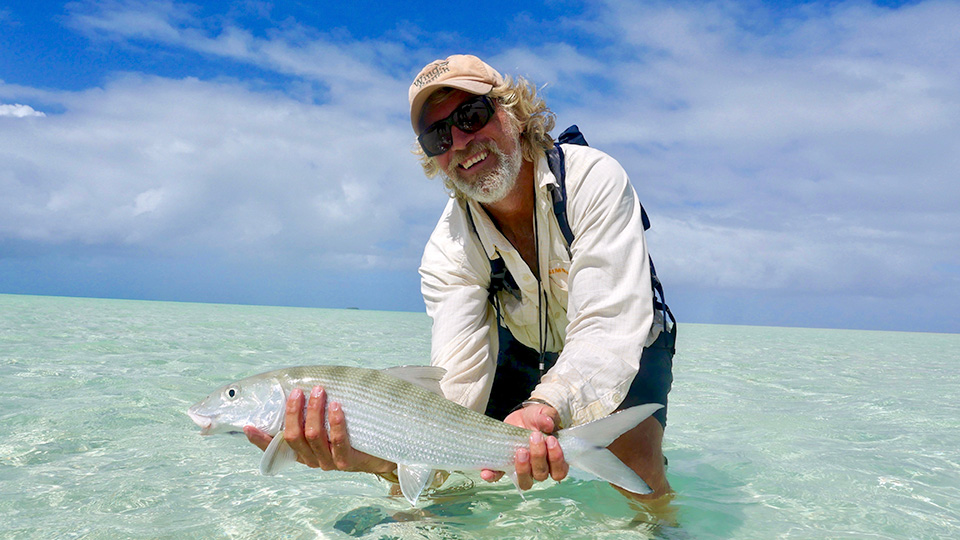

Curiosity is an essential element of the flat. All the creatures there are looking for something in that thin slice of a watery world. A human being walking a flat is an unusual event, and so I should expect a little attention. Of my many curious visitors, a beautiful red and rust brown turtle was the most conspicuous creature I’ve seen on the flat. From a long distance he was indistinguishable from a rock, except in that he moved. The first time we met, I followed him for a little way until I could tell what he even was. I’d never seen a brown turtle before. At about twenty yards I stopped to watch him, and then he turned and began very slowly swimming my way. I wanted to take a picture, but I didn’t want to spook him by taking my phone out, so I left it in my pocket and didn’t move. At about fifteen feet he poked his head out of the water and looked at me. And then he kept swimming over. Who knows what he might have been thinking. When he was literally about to touch my ankle with his snout, I blinked. I moved my leg just a tiny little bit, in case he was thinking of pecking at my foot. I wish I hadn’t because that settled it for him. Whatever kind of tree he thought I was, its roots were not supposed to move. He turned at a turtle’s version of light speed and swam away. We bumped into each other the next two days, but then as soon as he poked his head up out of the water and saw it was me again, he was out of there. So I guess he didn’t want to be my flats buddy after all.
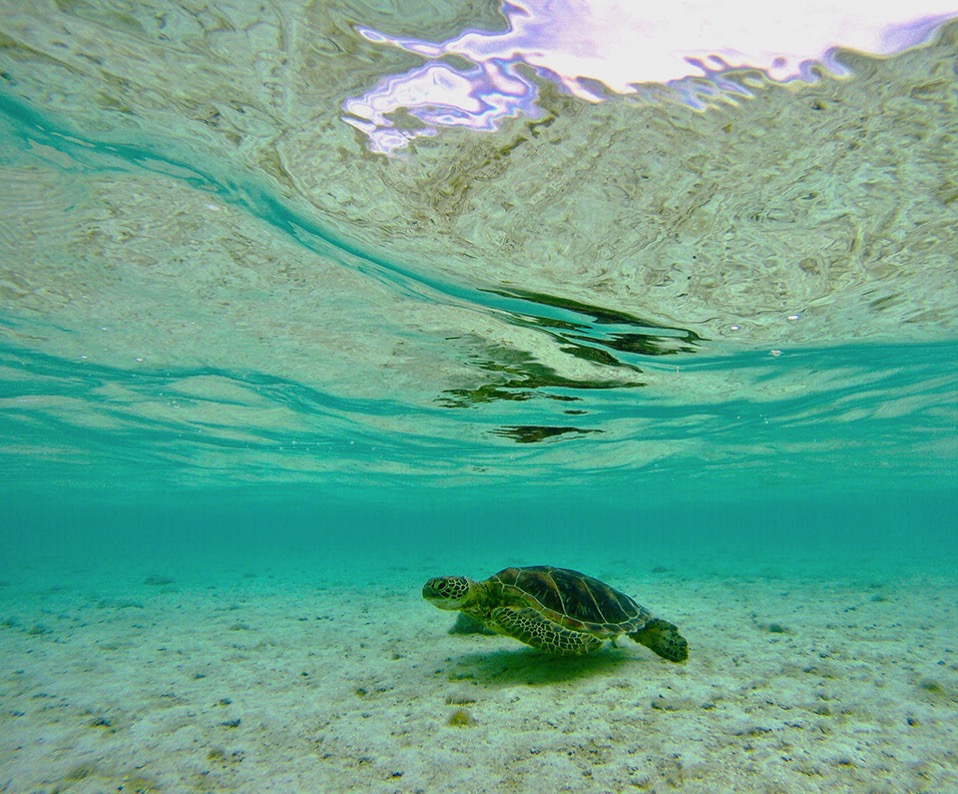


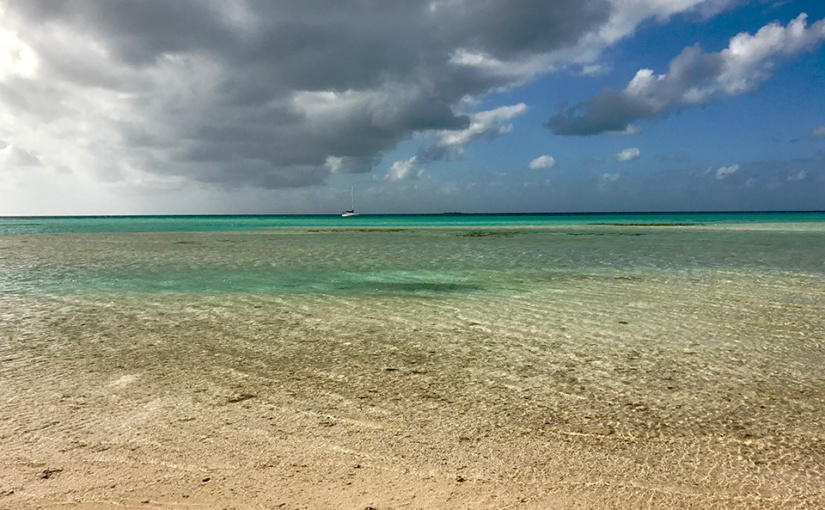
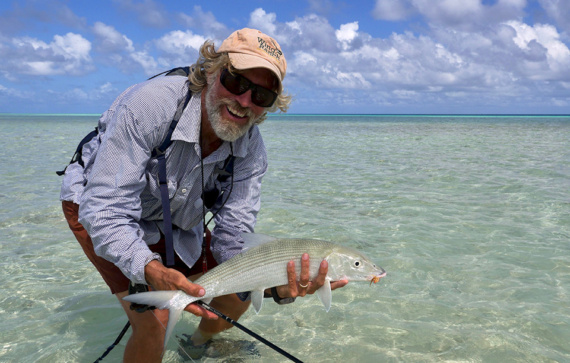
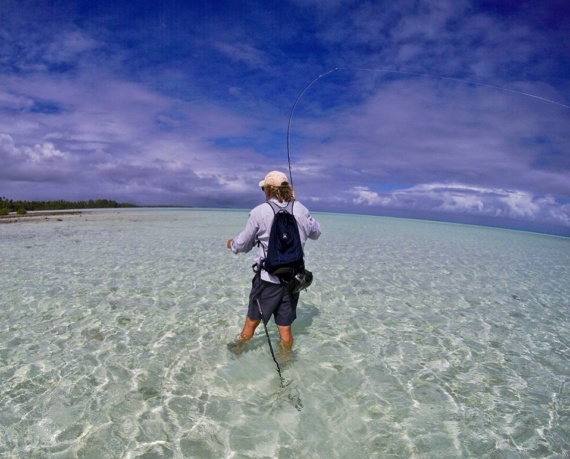
Hi Marcus(and Diana!), I know little about fishing(and next to nothing about doing so in salt water), but this was a mesmerizing read. What a passionate and patient recap to read on this foggy day, and those mirage-esque shots of the lively shallows never get old!
May the bonefish be biting!
max
Max!!! We miss you! Thanks for the kind words and glad the serenity came through in the post. I heard someone ask Marcus about WHY he loved to fish so much, so I think it inspired some thought on the subject. Glad the ‘mirage-esque’ shots don’t get ‘old,’ because I just made a whole new post with nothin’ but! Big hugs! (and THANKS for writing a comment!)